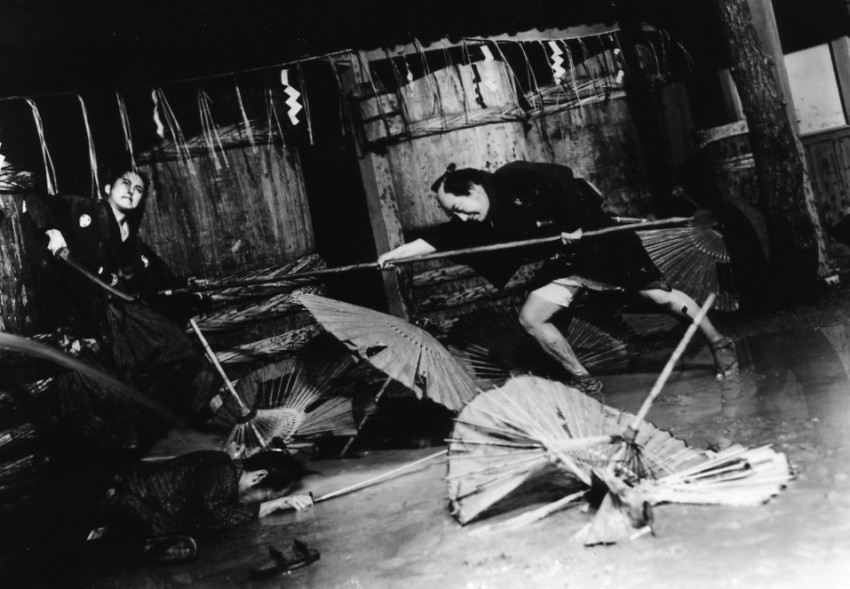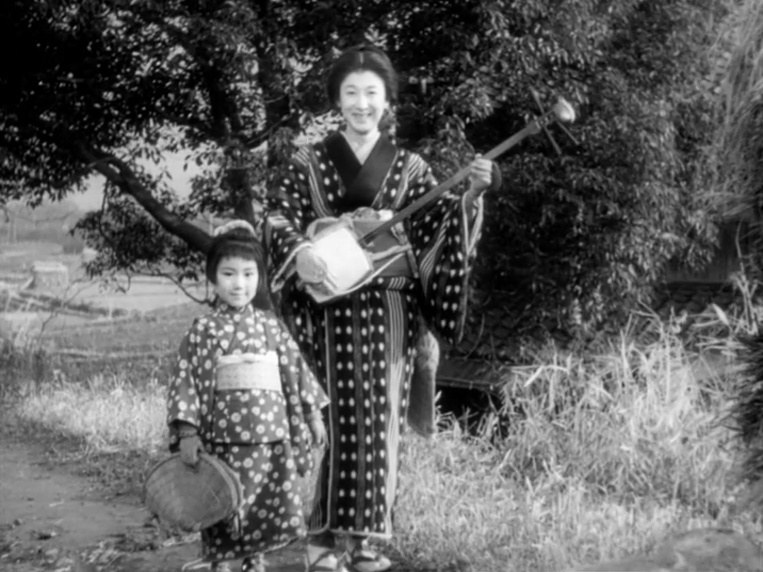Bloody Spear at Mount Fuji
November 9, 2018 · 0 comments
by Jeremy Clarke.
 Despite the bloody implications of its title, Bloody Spear At Mount Fuji (1955) is more like a period road movie, introducing a series of offbeat characters, each in their own unique situation. Whilst Mount Fuji puts in an appearance in the opening frame and in one of the many scenarios on the road, it’s only towards the end that we get a seven-minute fight scene involving a spear and a great deal of blood. Since the fight takes place near barrels of sake which get punctured during the mayhem, a good deal of wine is also spilled.
Despite the bloody implications of its title, Bloody Spear At Mount Fuji (1955) is more like a period road movie, introducing a series of offbeat characters, each in their own unique situation. Whilst Mount Fuji puts in an appearance in the opening frame and in one of the many scenarios on the road, it’s only towards the end that we get a seven-minute fight scene involving a spear and a great deal of blood. Since the fight takes place near barrels of sake which get punctured during the mayhem, a good deal of wine is also spilled.
The central character is not the samurai Sakura (Teruo Shimada) who has a drink problem and whose name in kanji reads as ‘alcohol smell’. Rather it’s his retainer and spear carrier Gonpachi (Chiezo Kataoka) who is accompanied by his own assistant Genta (Daisuke Kaito). As Sakura’s party travels along the Tokaido – the route connecting Edo to the old capital of Tokyo – orphan and spear-carrier hopeful Jiro (Motoharu Ueki) strikes up a friendship with Gonpachi. On the same journey are a wandering shamisen player (Chizuru Kitagawa), her small daughter Okin (Chie Ueki) and a pilgrim (Eitaro Shindo). The travellers are held up at one point when another samurai and his entourage block Tashiro the route with a picnic in full view of Mount Fuji. Other intrigues include a man forced to sell his daughter Otane (Yuriko Tashiro) into prostitution and a notorious thief on the loose.
 All this provides a very different view of the familiar samurai. Alongside a concern with social issues, director Tomu Uchida (1898-1970) represents samurai as interlopers or buffoons. He’s much more sympathetic to people lower down the social ladder, such as servants, orphans, itinerants and even thieves. The whole represents a reaction against the militarism which gripped Japan in the 1930s and led to a disastrous war, defeat and the subsequent American occupation.
All this provides a very different view of the familiar samurai. Alongside a concern with social issues, director Tomu Uchida (1898-1970) represents samurai as interlopers or buffoons. He’s much more sympathetic to people lower down the social ladder, such as servants, orphans, itinerants and even thieves. The whole represents a reaction against the militarism which gripped Japan in the 1930s and led to a disastrous war, defeat and the subsequent American occupation.
Uchida’s career spanned half a century and can be divided into three distinct phases. Between 1922 and 1942 he made some 45 films including silents and talkies. Between 1941 and 1954 he worked in Manchuria for the Manchukuo Film Association (Man-Ei) and its Chinese-owned successor corporation, mainly in newsreel documentary. Rumour has it that the sight of the post-surrender seppuku of the Man-Ei boss, Masahiko Amakusa, had persuaded Uchida that it would be safer for him to stay in China for a while as Tokyo’s post-war purges rooted out propaganda filmmakers.
He returned to Japan in 1954 and made 26 films with a progressive, left-wing focus on social justice. Jonathan Clements’s Anime: A History also notes that it was Uchida who was the bag-man for Toei, trying to persuade the stop-motion animator Tadahito Mochinaga, a colleague from his Man-Ei days, to sell his facilities to the studio. While Uchida’s powers of persuasion were found wanting, it was at Toei that he completed A Fugitive From The Past (1965), considered his masterpiece, in which a thief escapes a bungled heist and takes up with a prostitute. A 1999 critics’ poll in the film magazine Kinema Junpo rated it the third best Japanese film of all time, coming below Seven Samurai (Akira Kurosawa, 1954) and Floating Clouds (Mikio Naruse, 1955) but above Rashomon (Kurosawa, 1950) and Tokyo Story (Yasujiro Ozu, 1953). Such acclaim suggests a director whose films merit further investigation: hopefully Arrow Academy will release more.
Yet among Japanese film directors in the English speaking Western world Uchida remains relatively unknown. Several decades ago, Donald Richie in The Japanese Film: Art and Industry suggested four reasons for his obscurity. Virtually none of his pre-war films have survived. His post-war works are mostly period films, a genre owned by Kurosawa in the western mind. His personal, film-making style is, at best, eclectic. And finally, his post-war output was mostly at Toei, a company targeting the commercial, domestic market with little interest in international exposure.
However, something of a rehabilitation has taken place in the past decade. This can be traced back to the 2004 edition of Japan’s annual FILMeX Festival where a retrospective selection of Uchida’s works was shown in new, English subtitled prints. This had two immediate effects. The selection toured various festivals and cinemas throughout the world and Wild Side released some of the films on DVD in France in 2006. Curiously, none of these films were released on any home cinema format with English subtitles in the English-speaking world at the time.
Arrow Academy’s new Bloody Spear at Mount Fuji disc contains a number of extras from the Wild Side releases. The transfer looks good with nice, clear, readable English language subtitles. Jasper Sharp provides a commentary track with a little info on the film and a great deal more about the personnel involved and their place in wider Japanese history and film history. It was Sharp who along with Alexander Jacoby was responsible for bringing the FILMeX prints to London in late 2007.
However with Wild Side’s extras, Arrow have blurred the screen area containing French subtitles to add English subtitles below the mostly unreadable but still visible French ones which has the effect of blurring out the very bottom of the image too. This is annoying when clips of the films appear in these extras: personally I would have preferred the burned-in French subs left unblurred below the English ones. Perhaps there’s a contractual obligation here resulting from Arrow’s deal with Wild Side or their rights holders.
That said, the English-subtitled Wild Side extras include a superb, fifty-minute filmed interview with Uchida’s son Yusaku, who worked as an assistant director at Toei on some of his father’s post-war films, recalling his career and working methods on the set in fascinating detail.
Bloody Spear At Mount Fuji is out on Blu-ray from Arrow Academy.
Leave a Reply